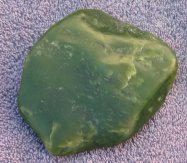Jade is a valued stone used in the production of art work in many parts of the world. It is particularly associated with China and with Mesoamerica.
The word "jade" is applied to either of two quite similar kinds of stone: jadeite and nephrite.
- Jadeite is a mineral (a member of the pyroxene group).
- Nephrite is a subtype of the mineral actinolite (and a member of the amphibole group).
In their purest forms, both are whitish, other colors being due to impurities, usually iron and/or iron oxides. Bluish green is the most commonly found variant for both materials.
Nephrite (referred to as "soft jade" [ruǎnyù 软玉] in Chinese) is slightly softer and less glassy than jadeite. It is a calcium-magnesium silicate, with short masses of interlocking microscopic fibers that make it tough and hard to work. Nephrite has a hardness of 6.5 on the Mohs scale, and cannot be carved (as marble can, for example), but must be worked by sawing it or rubbing it with abrasive sands, a technique developed in China by earliest dynastic times. Recent evidence suggests a good deal of ancient Chinese experimentation with different types of abrasives, possibly including powdered diamonds.
By the Hàn Dynasty (206 BC - AD 220), nephrite was imported into China from Turkistan, a vast region of central Asia including what is today Xīnjiāng Province, and it is probable that Turkistan was the main jade source in earlier times as well, suggesting an important relationship between the use of jade and the maintenance of a long-distance trade system.
Nephrite is also known from Siberia, eastern and southern Europe, and the Americas, as well as from the Philippines, New Guinea, New Zealand, and Australia.  The picture shows a piece of polished nephrite from British Columbia.
The picture shows a piece of polished nephrite from British Columbia.
Jadeite (called "hard jade" [yìngyù 硬玉] in Chinese) is somewhat harder than nephrite. It is a sodium aluminum silicate that forms tight-packed aggregates of small grains and hence is more brittle than nephrite but able to take a higher, glass-like polish. Jadeite is much less common than nephrite. Today it is found in small quantities in Burma, Mexico, and California, but objects made of jadeite are known from prehistoric Europe, and therefore other sources are assumed to have existed at one time.
Jadeite was not used in China until the XVIIIth century, when its superior gleam gave it pride of place over nephrite, the rougher texture of which came to be known as "tangerine skin jade" in Chinese.
The Chinese term for jade, yù 玉, is also sometimes used to refer a range of other hard, similarly colored stones capable of taking a high gloss, such as onyx, agate, lapis lazuli, and the fossilized tree sap we know as amber.
In Mesoamerica a range of "jades" were used in the production of luxury items. Rare as it is, jadeite is far commoner in Mesoamerica than nephrite is. In the absence of metal tools, new world jade workers made use of stone tools (including tools that were themselves made of jade) as well as various abrasive sands (including powdered jadeite).
Because of its usually blue-green color, jade in Mesoamerica became a symbol of water, sky, or vegetation, and even of life, and thus jade objects potentially had meaning and value beyond their obvious properties. Not surprisingly, there is evidence of people throughout Mesoamerican history treasuring jade heirlooms from earlier eras.
Etymology. Modern Europeans seem to have come upon the stone through the Spanish contact with the Americas. The Aztecs called the stone chalchihuitl and attributed to it the ability to heal diseases of the liver and kidney. Probably for this reason the Spanish who settled among them translated the name as piedra de ijada "stone for the side." It is from the Spanish ijada ("side") that the modern English terms "jade" and "jadeite" derive. When classified in Latin, the Latin name was lapidis nephriticus, "stone for the kidney," essentially a translation of the Spanish term, reflecting the same Aztec association with healing that had inspired the Spanish word. In other words, the Latin was derived from an Aztec medical belief, via the Spanish. This Latin term, lapidis nephriticus, became the source of the English term "nephrite." (This is something you always wanted to know, right?)
Photo by DKJ
